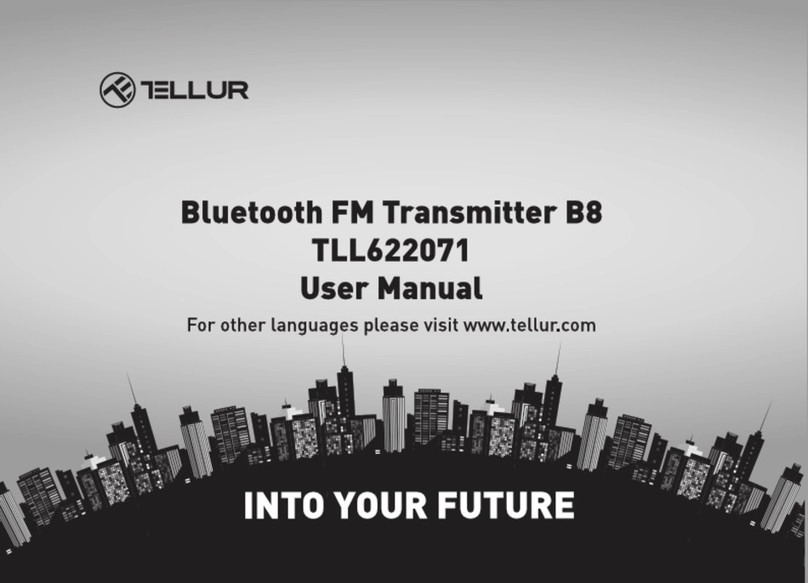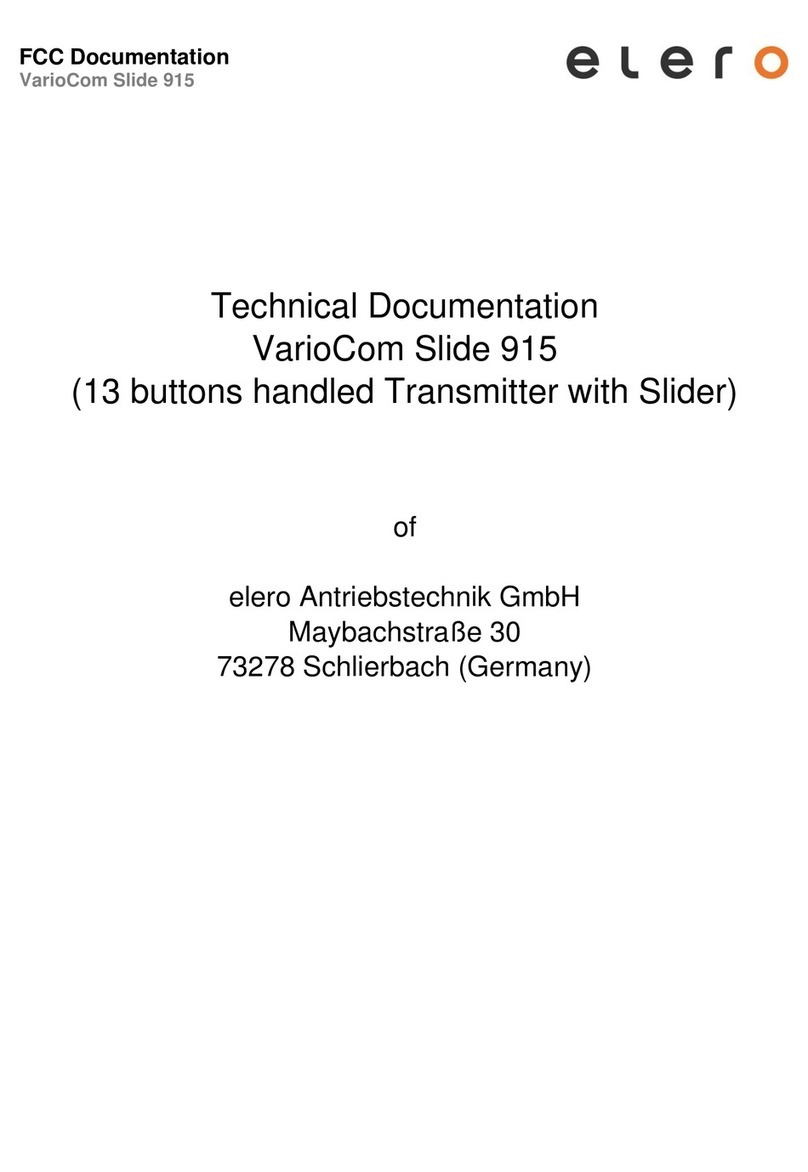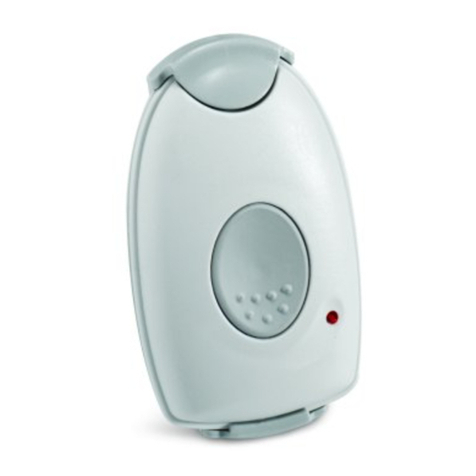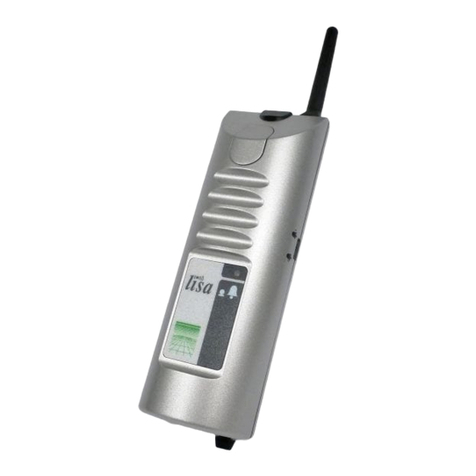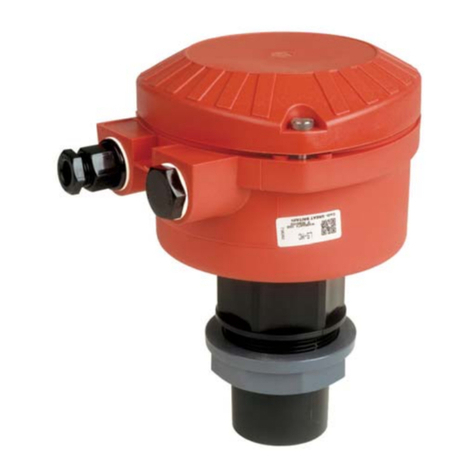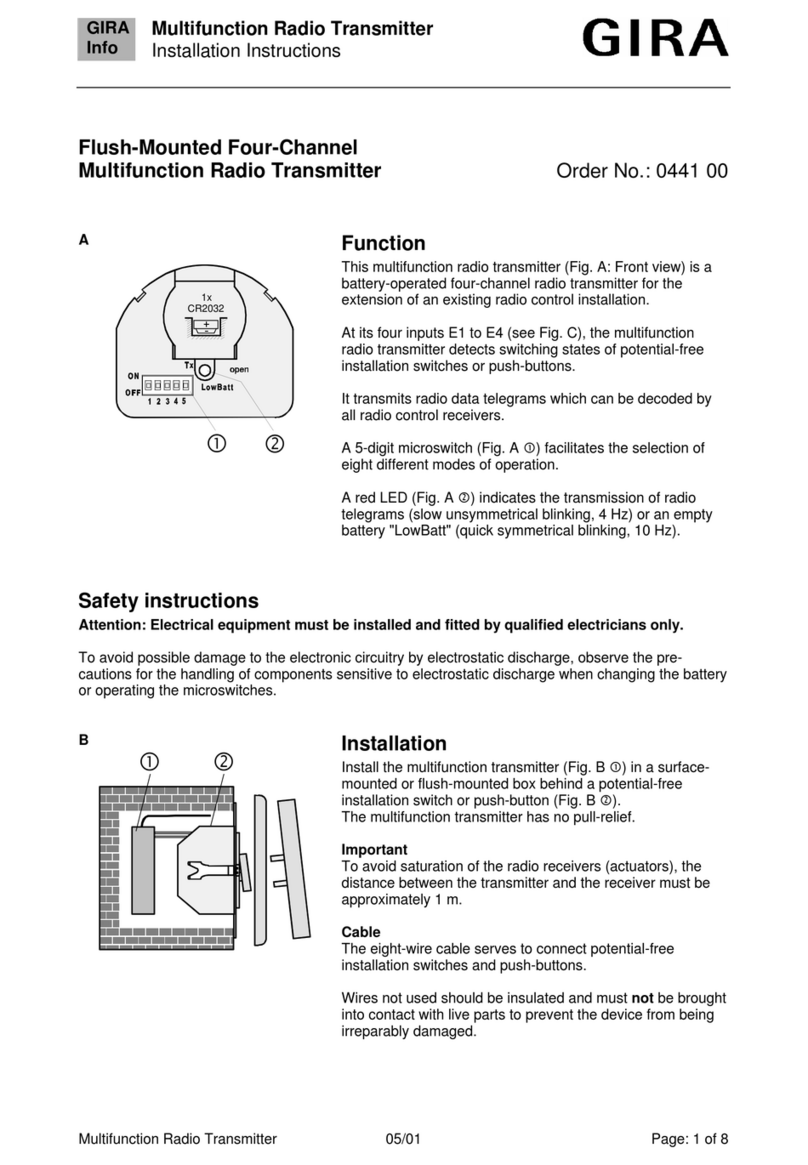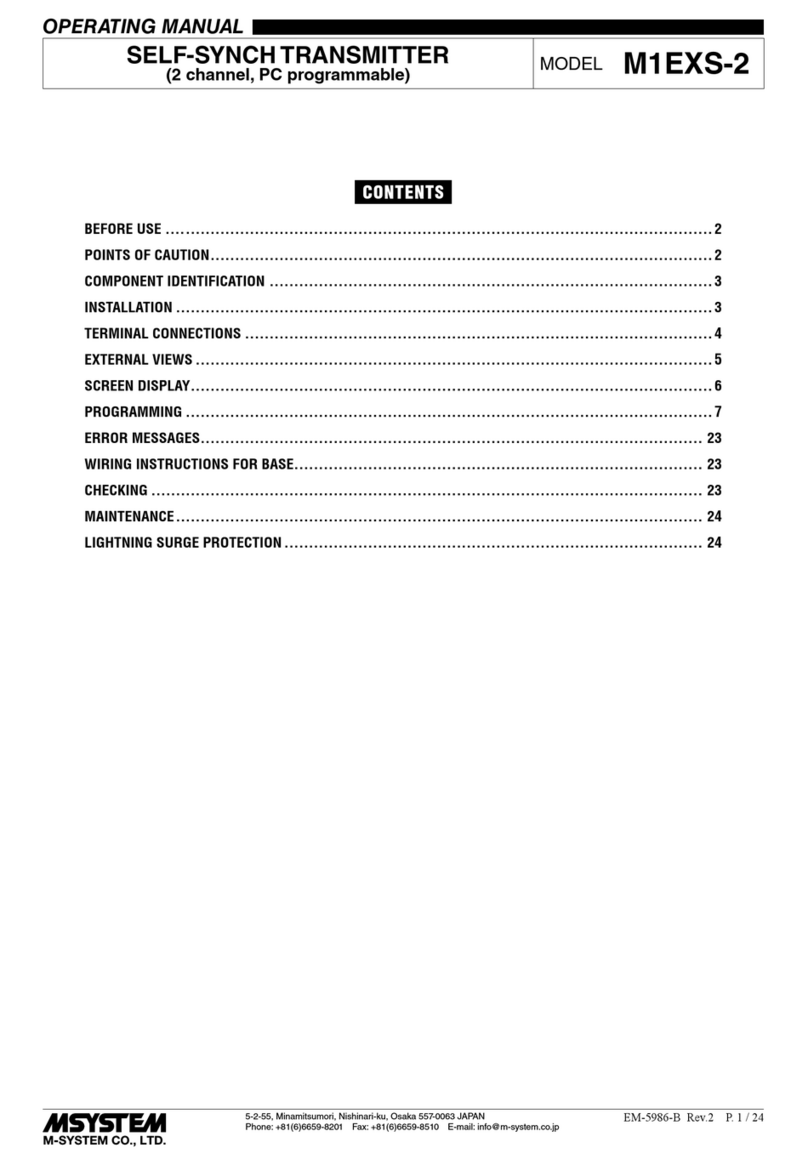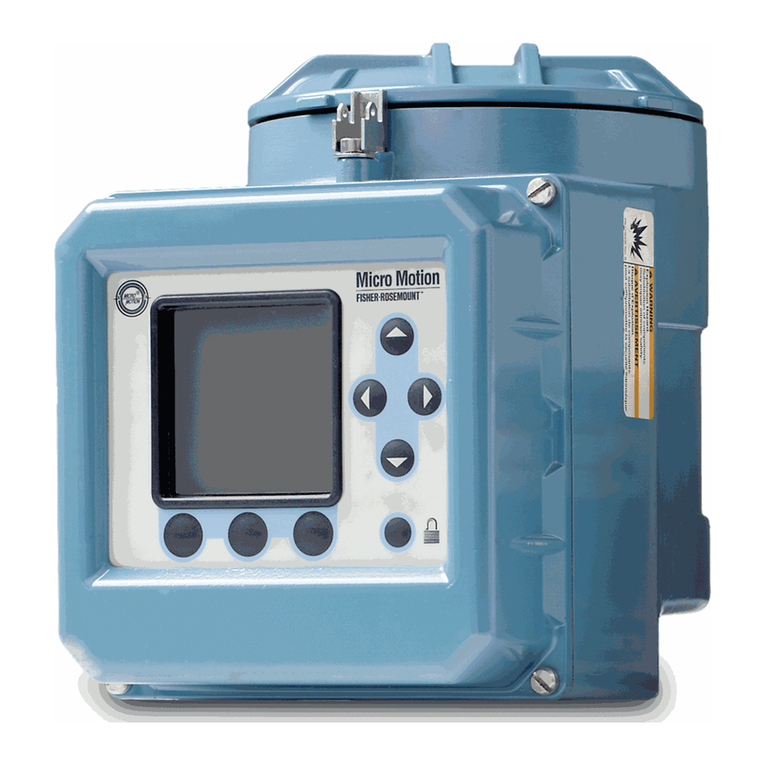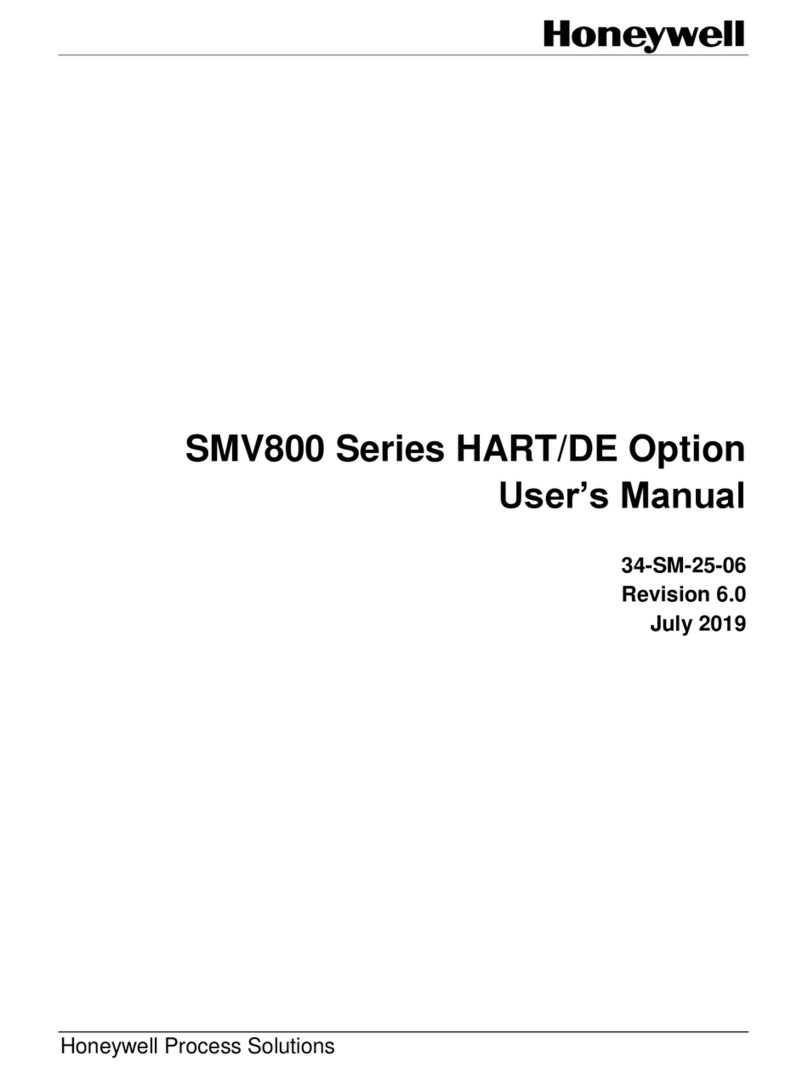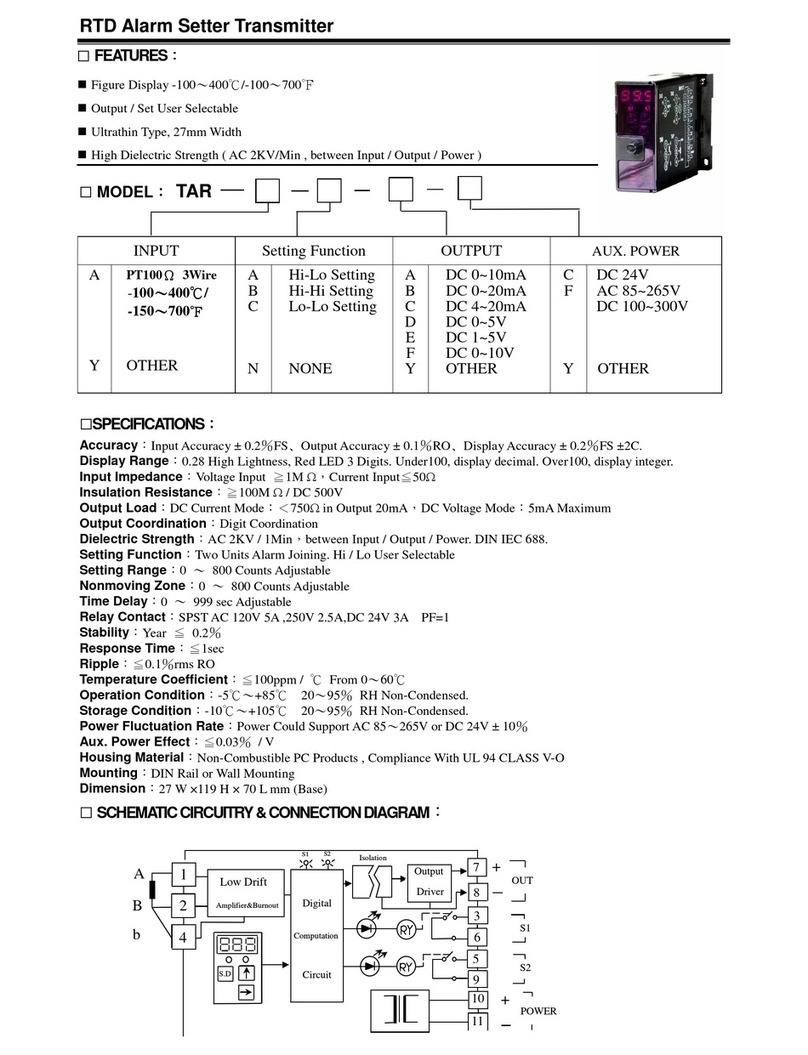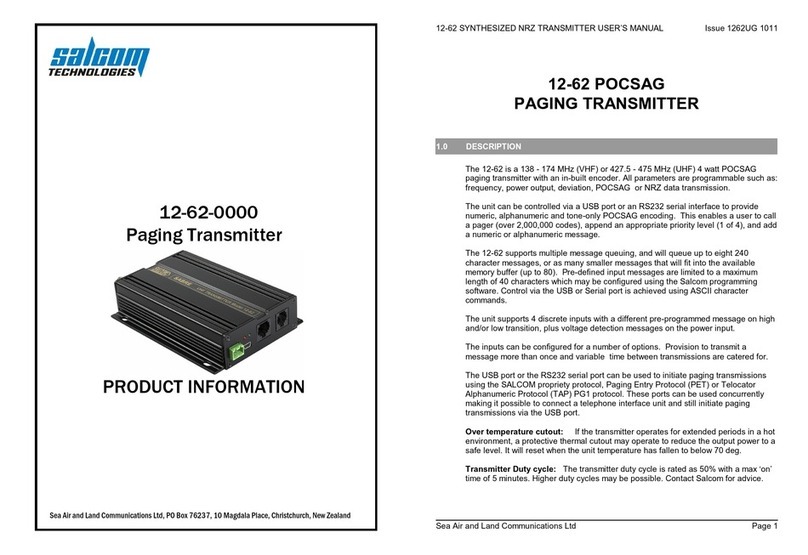ELCA E1 Series User manual

E1_VETTA_P1-00_ENG
OTHER LANGUAGES
TRANSMITTING UNIT USER MANUAL
Part 1
AT E1-VETTA
E1
Instructions translated from the original
0408MA000268
https://qrcode.elcaradio.biz/man/83d1e403a35e6f1053e101c0ca1f2c81


ENG
WARNING
THIS PART OF THE MANUAL CONSISTS OF: Part 1 – Information, instructions and general warnings for the Transmitting Unit and
its charging system. The manual consists of Part 1 "Transmitting Unit user manual", Part 2 "Receiving Unit user manual", Position
of the controls and the Connection diagram.
THIS MANUAL, INCLUDING ALL ITS PARTS, AND ALL THE INSTRUCTIONS CONTAINED IN IT MUST BE READ CAREFULLY AND
UNDERSTOOD BEFORE EACH INSTALLATION, USE, MAINTENANCE OR REPARATION OPERATION OF THE ELCA RADIO REMOTE CONTROL.
FAILURE TO READ THE MANUAL AND COMPLY WITH ALL THE APPLICABLE WARNINGS AND INSTRUCTIONS, OR ANY RESTRICTION
PROVIDED IN THIS MANUAL CAN CAUSE SERIOUS PHYSICAL INJURIES OR DEATH AND/OR DAMAGE TO PROPERTY.
THE ELCA RADIO REMOTE CONTROL IS NOT AN INDEPENDENT PRODUCT AND IS EXCLUSIVELY A COMPONENT OF A MACHINE THAT:
-PERMITS A RADIO REMOTE CONTROL TO BE USED IN AN APPROPRIATE MANNER,
-CAN BE OPERATED SAFELY AND IN COMPLIANCE WITH ALL LEGAL PROVISIONS, REGULATIONS AND STANDARDS APPLICABLE
TO THIS RADIO REMOTE CONTROL.
ACCORDINGLY, IT IS THE RESPONSIBILITY OF THE MANUFACTURER AND THE DESIGNERS OF THE MACHINE ON WHICH YOU INTEND
TO INSTALL THE ELCA RADIO REMOTE CONTROL to carry out a careful and in-depth risk assessment to determine whether the Elca
radio remote control is suitable for the safe and efcient use of the Machine, taking into account the conditions of use and the
intended uses, and that the installation, maintenance and use of the Elca radio remote control and all its components are carried
out only and entirely in accordance with this Manual and in compliance with all local safety rules, standards and regulations
(referred to herein as "Laws, Regulations and Standards").
With reference to the US market, the Laws, regulations and Standards include all regulations and standards of the Occupational
Safety & Health Administration (OSHA) (http://www.osha.gov), all federal, state and local laws and provisions, the construction
and electric devices codes and all applicable standards, including, bit not only, ANSI standards.

It is the responsibility of the Manufacturer and the designers of the Machine on which you intends to install and use the Elca Radio
Remote Control to make sure that the structure, condition, organisation and the markings of the Machine as well as how it is
installed in its place of use are appropriate and allow the Machine to be used and controlled safely and reliably using the interface
of the Elca Radio Remote Control.
IT IS THE RESPONSIBILITY OF THE USER OF THE SYSTEM AND THEIR DESIGNERS that the installation, maintenance and use of
the Elca Radio Remote Control and all its components are carried out only and entirely in accordance with this Manual and in
compliance with all applicable Laws, Regulations and Standards, also local. It is also the responsibility of the Owner, the system
user and their designers to make sure that the structure, the condition, the organisation and the markings of the Machine and the
place where the Elca Radio Remote Control is installed and used are appropriate and allow the Machine to be used and controlled
safely and reliably using the interface of the Elca Radio Remote Control.
ONLY QUALIFIED AND SUITABLY TRAINED PERSONNEL ARE ALLOWED TO CONTROL AND USE THE ELCA RADIO REMOTE CONTROL
AND THE MACHINE CONTROLLED BY THE ELCA RADIO REMOTE CONTROL. ONLY QUALIFIED AND SUITABLY TRAINED PERSONNEL
ARE ALLOWED ACCESS TO THE VICINITY OF THE MACHINE CONTROLLED BY THE ELCA RADIO REMOTE CONTROL.
INADEQUATE INSTALLATION, OPERATION, MAINTENANCE AND ASSISTANCE OPERATIONS ON THE ELCA RADIO REMOTE CONTROL
CAN CAUSE SERIOUS PHYSICAL DAMAGE OR DEATH AND/OR DAMAGE TO PROPERTY. For further assistance refer to this Manual and
all its parts, or else contact Elca. Elca is not responsible for and accepts no liability for any installation of the Elca Radio Remote
Control carried out by Elca itself, or for any use or maintenance of the Elca Radio Remote Control that do not fully comply with all
the instructions and warnings supplied by Elca and with all applicable Laws, Regulations and Standards, also local.
Elca is not responsible for and accepts no liability for any alterations or modications of the Elca Radio Remote Control, or for the
use of non-original Elca parts that are used together or incorporated inside the Radio Remote Control itself.
IT IS THE RESPONSIBILITY OF THE OWNER, AND USER OF THE SYSTEM AND ITS DESIGNERS to make sure that the Elca Radio
Remote Control is always maintained and serviced in compliance with all the instructions and warnings provided by Elca, and in
compliance with all applicable Laws, Regulations and Standards, also local.

ENG
IT IS THE RESPONSIBILITY OF THE OWNER, THE USER OF THE SYSTEM AND THEIR EMPLOYEES MANAGERS AND SUPERVISORS
to make sure that all the Users of the Elca Radio Remote Control and all those that work or will work with or near the Machine
operated by or through the Elca Radio Remote Control are completely and adequately instructed and trained by qualied persons on
the correct and safe use of the Elca Radio Remote Control and the Machine, including without restrictions the complete familiarity
with and understanding of the warnings and instructions provided by Elca, and all applicable Laws, Regulations and Standards,
also local; it is equally also their responsibility to make sure that these Users or other Persons use or work always in a safe
manner with the Elca Radio Remote Control and e ONLY in compliance with the instructions and warnings provided by Elca and in
compliance with all applicable Laws, Regulations and Standards, also local. FAILURE TO COMPLY WITH THIS INSTRUCTION CAN
CAUSE SERIOUS PHYSICAL INJURIES OR DEATH AND/OR DAMAGE TO PROPERTY.
IT IS THE RESPONSIBILITY OF THE OWNER, THE USER OF THE SYSTEM AND THEIR EMPLOYEES MANAGERS AND SUPERVISORS
to make sure that the area where the Machine is located and is operated by the Elca Radio Remote Control is clearly marked and
indicated, in compliance with all the instructions and warnings provided by Elca, and in compliance with all applicable Laws,
Regulations and Standards, also local, and that there are sufcient indications that notify EVERYONE that the machine is operated
by or through a Radio Remote Control, and that prohibit any unauthorised access to the area. FAILURE TO COMPLY WITH THIS
INSTRUCTION CAN CAUSE SERIOUS PHYSICAL INJURIES OR DEATH AND/OR DAMAGE TO PROPERTY.
IF THE ELCA RADIO REMOTE CONTROL IS NOT USED SAFELY AND IN ADHERENCE TO THE INSTRUCTIONS AND WARNING PROVIDED
BY ELCA, AND IN CONFORMITY WITH APPLICABLE LAWS, REGULATIONS AND STANDARDS , ALSO LOCAL, AND/OR IF USE OF
THE RADIO REMOTE CONTROL IS PERMITTED TO USERS OR OTHER PERSONS THAT ARE NOT ADEQUATELY TRAINED TO USE THE
SYSTEM OR THE MACHINE ON WHICH IT IS INSTALLED SAFELY AND CORRECTLY, CAN CAUSE SERIOUS INJURIES OR DEATH AND/
OR DAMAGE TO PROPERTY.

INDEX
1 Use and Maintenance Manual .......................................................................................................................................... 9
1.1 Structure ................................................................................................................................................................ 9
1.2 Denitions ............................................................................................................................................................... 9
1.3 Symbols ................................................................................................................................................................ 10
1.4 Who these instructions are for .................................................................................................................................. 10
1.5 Storage of the instructions ....................................................................................................................................... 11
1.6 Updating the Manual ............................................................................................................................................... 11
1.7 Intellectual property ............................................................................................................................................... 11
2 Series, Radio Remote Control and Unit .......................................................................................................................... 12
3 Conformity ................................................................................................................................................................... 12
3.1 CE conformity ........................................................................................................................................................ 12
3.2 Countries of use ..................................................................................................................................................... 12
4 Manufacturer's identication ........................................................................................................................................ 13
5 Assistance and spare parts ........................................................................................................................................... 13
6 Warranty ...................................................................................................................................................................... 13
7 Safety warnings ............................................................................................................................................................ 14
7.1 General information ................................................................................................................................................ 14
7.2 Risk analysis for remote-controlled Machines .............................................................................................................. 17
7.3 Delay in the command response time ........................................................................................................................ 17
7.4 Unintended activations of the commands .................................................................................................................... 18
8 Radio Remote Control of the Range E1 .......................................................................................................................... 19
8.1 Characteristics ....................................................................................................................................................... 19
8.2 Frequencies and radio link ....................................................................................................................................... 19
8.3 Technical data of the range E1 .................................................................................................................................. 21
8.4 Identication of the Radio Remote Control .................................................................................................................. 21
8.5 Transportation and/or storage .................................................................................................................................. 22
8.6 Applications ........................................................................................................................................................... 22
8.7 Classication of the controls ..................................................................................................................................... 24
9 Instructions for the User ............................................................................................................................................... 25
9.1 Use of the Radio Remote Control and operating conditions ............................................................................................ 25
9.2 General warnings for the User .................................................................................................................................. 25
9.3 Environmental conditions of use ............................................................................................................................... 27
9.4 Warnings before starting work .................................................................................................................................. 27

ENG
9.5 Warnings during normal use ..................................................................................................................................... 27
9.6 Warnings for after its use ........................................................................................................................................ 28
9.7 Belt ...................................................................................................................................................................... 28
10 Description of the Transmitting Unit ............................................................................................................................. 30
10.1 Technical data ........................................................................................................................................................ 31
10.2 The Position of the controls and Connection diagram .................................................................................................... 31
10.3 Transmitting Unit data plate ..................................................................................................................................... 31
10.4 Indicator lights ...................................................................................................................................................... 32
11 General operating instructions ...................................................................................................................................... 34
11.1 START command .................................................................................................................................................... 34
11.2 STOP button .......................................................................................................................................................... 34
11.3 Starting the Radio Remote Control ............................................................................................................................ 35
11.4 Activating the controls ............................................................................................................................................ 36
11.5 Interruption of the radio link .................................................................................................................................... 36
11.6 Automatic switching off of the Transmitting Unit .......................................................................................................... 36
11.7 Charging the Transmitting Unit ................................................................................................................................. 36
11.8 Switching off of the Transmitting Unit ........................................................................................................................ 37
11.9 "Customised Signals" function .................................................................................................................................. 37
11.10 Replacing the Transmitting Unit ................................................................................................................................ 37
12 Charging system of the Transmitting Unit ..................................................................................................................... 39
12.1 Instructions for use ................................................................................................................................................ 39
12.2 Charging indicator lights .......................................................................................................................................... 40
12.3 Connecting the charging system ............................................................................................................................... 40
12.4 Removing the charging system ................................................................................................................................. 41
12.5 Charge level indicator of the Transmitting Unit ............................................................................................................ 41
13 Maintenance ................................................................................................................................................................. 42
13.1 Maintenance of the Radio Remote Control - general instructions ..................................................................................... 42
13.2 Routine maintenance .............................................................................................................................................. 43
13.3 Special maintenance ............................................................................................................................................... 44
13.4 Actuators (buttons, joysticks and potentiometers) ....................................................................................................... 45
14 Guide to solving problems ............................................................................................................................................. 46
14.1 Solutions in the event of malfunctions ....................................................................................................................... 46
15 Decommissioning and disposal ...................................................................................................................................... 48
15.1 Decommissioning ................................................................................................................................................... 48
15.2 Disposal ................................................................................................................................................................ 48


ENG
ELCA
Use and Maintenance Manual
9
1 Use and Maintenance Manual
1.1 Structure
The Instruction Manual for use and maintenance consists of two parts:
together they constitute the Elca Radio Remote Control of the series
E1. The Manual should be read, understood and applied by the Owner
of the Radio Remote Control, by the User and by all those who, for
whatever reason, operate the Radio Remote Control or the Machine
on which it is installed.
This part (called Part 1) deals with the Transmitting Unit and the
charging system. Part 2 (to which reference is made) deals with the
Receiving Unit.
The contents of the Instruction manual for use and maintenance is
supplemented by the following documents:
-“Arrangement of Controls” that contains the conguration of the
Transmitting Unit and the names of the commands sent to the
Receiving Unit;
-“Connection diagram” that indicates the correspondence of the
commands sent by the Transmitting Unit and those available in
the Receiving Unit .
The Instruction manual for use and maintenance is an integral part
of the Elca Radio Remote Control and therefore of the Machine that is
equipped with the Radio Remote Control. It is the responsibility of the
Manufacturer of the Machine or the system on which the Radio Remote
Control is installed to ensure that the Instruction Manual is inserted in
the instruction manual of the Machine.
Further information on the operation of the radio remote control system,
particularly if made to the customer's own specications, can be found
in the documents attached to the manual that should be considered as
an integral part of the Manual itself.
1.2 Denitions
Please contact Elca if any instructions, symbols, warnings or
images are unclear or incomprehensible or if you have any
doubts or questions.
The meanings of the terms in the entire Manual, including all its parts,
are shown below:
-Unit: the individual units, transmitting and receiving, that make
up the Elca Radio Remote Control.
-Radio Remote Control: wireless control system (CCS: Cableless
Control System) composed of a Transmitting unit and a Receiving
unit that communicate with each other via radio connection.
-Transmitting unit: portable component (remote station) through
which the user interfaces with the Radio Remote Control.
-Receiving unit: component xed stably to the Machine (base
station) that constitutes an interface between the Radio Remote
Control and the other parts of the machine.
-Machine:the machine, as dened by Directive 2006/42/CE and
by other local regulations, and every other device, machinery,
equipment, system, application, etc., on which the Elca Radio
Remote Control is installed or that is controlled by it.
-Manufacturer: the entity that designs and/or constructs a Machine
and that decides to install a Radio Remote Control in order to
operate the Machine.
-Installer: the entity, specialised technician, that plans and/or
carries out the installation of the Elca Radio Remote Control on a
Machine in order to operate its controls.
-User: the entity that materially uses the Elca Radio Remote Control
as a device for operating the controls of a Machine.

Use and Maintenance Manual
ELCA
10
-Maintenance technician: the entity, specialised technician, that
carries out routine and extraordinary maintenance on the Elca
Radio Remote Control, in order to keep it undamaged and running
efciently.
-Manual or Instruction manual: document consisting of Part 1
(Transmitting unit and its charging system), Part 2 (Receiving unit),
Position of the controls and the Connection diagram.
-Person: individual, natural or legal person and/or every entity,
however considered.
-Owner: the owner of the Radio Remote Control.
The functions indicated for the Manufacturer, the Installer, the User
and the Maintenance Technician can be carried out by a single entity,
where these have the skills and assume the relative responsibilities.
Each entity should be aware of the instructions in the Manual for the
work that it carries out.
For example, if a Manufacturer also acts as an Installer, and/or
Maintenance Specialist, it should understand and follow also the
instructions specically directed at these entities. The same criteria
should be applied in the case where, for example, a User assumes the
function of manufacturer and/or Installer.
1.3 Symbols
The parts of the Manual that are drawn attention to by this
symbol should be read very carefully.
The parts of the Manual that are drawn attention to
by this symbol contain warnings, information and/or
instructions that are extremely important for safety
issues: failure to understand these parts could be
dangerous for Persons and/or property.
1.4 Who these instructions are for
The Instruction Manual is for the User, the Owner of the Radio Remote
Control, the Installers, the Manufacturers and all those Persons who,
for whatever reason, are operating the Radio Remote Control or the
Machine on which it is installed.
The Manual should be read, understood and applied, in all its parts, by:
-the Owner and/or the person responsible for operating the Machine
and/or the Elca Radio Remote Control;
-the Manufacturer of the Machine who decides to equip it with a
Radio Remote Control;
-the Installer of the Radio Remote Control or the entity that takes
care of its tting on a Machine, on a device, on a system, etc., and/
or that has the responsibility for its operation;
-the safety manager of the workplace where the Radio Remote
Control is used;
-the Users, namely those who materially, and for any purpose, are
enabled/authorised/entrusted with using the Radio Remote Control
or simply nd themselves in this situation;

ENG
ELCA
Use and Maintenance Manual
11
-the Maintenance technician;
-Those who, for any reason, nd themselves operating the Radio
Remote Control and/or the Machine, the system, the device and/
or the system on which the Elca Radio Remote Control is installed,
or which is controlled by it.
The instructions concerning the installation and
maintenance of the Radio Remote Control are for
qualied personnel and for their application specialised
professional expertise is required: none of the operations
for which qualied personnel are required can be carried
out by Persons or entities that do not have the specic
professional skill required.
1.5 Storage of the instructions
The Instruction Manual should be taken good care of and should
accompany the Radio Remote Control throughout its working life.
No part of the manual should be removed, torn or arbitrarily modied.
The Instruction Manual should be available for all those requiring it and
at any moment it becomes necessary to consult it.
Another copy of the Manual should be requested if it deteriorates.
The copy will be supplied after communicating the serial number of the
Radio Remote Control and at the expense of the person requesting it.
1.6 Updating the Manual
The contents of this manual are subject to change without prior notice,
therefore the operator is required to verify (before using the radio
remote control) that the information contained in this publication is
consistent with the device in their possession.
Elca is solely responsible for the instructions compiled and validated
by Elca itself (Original Instructions); in order to be able to check the
accuracy of the translation, any translations should always accompany
the Original Instructions.
Contact ELCA in the event there are instructions, warnings or indications
which may prove to be unclear.
1.7 Intellectual property
This manual and any annexed documents are the property of ELCA and
all rights are reserved. No part of this publication (for example the
structure, the contents, the instructions, the gures, the diagrams, the
photos) may be reproduced or transmitted (including photocopies and
web) for any reason without the written authorisation of Elca.

Series, Radio Remote Control and Unit
ELCA
12
2 Series, Radio Remote Control and Unit
The Manual concerns the Transmitting Unit of an Elca Radio Remote
Control in the E1 series.
Elca Radio Remote Controls provide a control interface to e used on
Machines to manage the command and control system.
The Radio Remote Controls have been designed to be used at a suitable
distance and position.
A Transmitting Unit and a Receiving Unit make up the Radio Remote
Control of the E1 series.
3 Conformity
It is the responsibility of the recipients of these instructions to:
-check the radio frequency band permitted in the country where it
will be used;
-check that the Radio Remote Control operates inside this band;
-check the country's applicable standards;
-check that the Radio Remote Control operates correctly in conformity
with them.
In no way can the conformity of the Radio Remote Control be modied,
making changes to it or carrying out technical interventions that change
the way it works.
For the instructions and use of the Elca Radio Remote Controls, local
regulations must be respected.
These regulations obligate the protection of the conformity of the
products with local regulations, and the specic standards regarding
the safe use of the Radio Remote Controls or electric devices, both
inside and outside the workplace.
3.1 CE conformity
One of the indispensable requisites for the Radio Remote Control have
CE conformity is that it operates at one of the permitted frequencies,
based on existing provisions in the European Union.
The Radio Remote Controls in the E1 series operate in the 434,050-
434,790MHz frequency band, therefore they are in conformity with
Directive 2014/53/UE (RED) and its essential requirements.
Admission to the Radio Remote Control market is permitted since it
conforms to harmonised rules in the EU declaration of conformity in
force and applicable at the time this manual was printed.
The EU declaration of conformity of the Elca the Radio Remote Control
is provided enclosed with the Radio Remote Control itself.
3.2 Countries of use
The Radio Remote Controls in the E1 range, which operate in the
434,050-434,790MHz frequency band, can be used within the EU
(European Union) and EFTA (European Free Trade Association).

ENG
ELCA
Manufacturer's identication
13
4 Manufacturer's identication
Radio Remote Control
Manufacturer: ELCA S.r.l.
Registered ofce: Via del Commercio, 7/b – 36065
Mussolente (VI) - ITALY
Telephone: +39 0424 578500
Fax: +39 0424 578520
E-mail: [email protected]
Site: www.elcaradio.com
5 Assistance and spare parts
For technical assistance and/or spare parts, please contact Elca.
When sending a request regarding an Elca Radio Remote Control the
serial number (Serial Num.) of the Radio Remote Control itself must be
provided. The serial number (Serial Num) can be found on the unit's
data plate (see paragraph 10.3).
6 Warranty
The general warranty conditions can be found on the sheet enclosed
with this manual.
It is also possible to see the warranty conditions in the relative section
of the web site www.elcaradio.com.

Safety warnings
ELCA
14
7 Safety warnings
7.1 General information
All the warnings and instructions contained in this
chapter are relevant for safety purposes.
Failure to follow the instructions in the Manual supplied
by Elca and applicable safety legal provisions, also local,
regulations, norms and standards can cause serious
injuries to Persons and damage to property.
It is the responsibility of the Manufacturer and/or the
designer of the Machine, the Installer, the Maintenance
Technician and the Persons responsible for the use of
the Machine and the workplace, that the installation,
maintenance and use of the Elca Radio Remote Control
and all its components are done only and entirely in
compliance with the instructions provided by Elca e and
in conformity with all applicable safety standards and
regulations in force in the countries where the Machine
and Radio Remote Control are used.
The Manufacturer of the Machine bears responsibility
for the installation and use of Radio Remote Control on
any application.
The Manufacturer of the Machine or whoever intends to use or install
an Elca Radio Remote Control on a Machine should rst of all:
-check whether the Machine that you want to equip with a Radio
Remote Control is suitable for being used with a Radio Remote
Control safely and efciently;
-carry out a comprehensive risk assessment taking into contact the
construction, functional and/or performance characteristics of the
Machine, the use of the Machine, the location and the environment
where the Machine will be used, the structure where the Machine
will be or is installed, the interaction between the Machine and the
other equipment and the personnel, the safety conditions when the
Machine is operating, the effective and potential different conditions
of use, the conditions that can be created after the installation of
a Radio Remote Control and the characteristics and limitations of
the Elca Radio Remote Control.
To this end refer to, but not only, ISO 12100 and ISO 14121, that lay
down the conditions through which a correct comprehensive risk analysis
can be carried out as well as the adoption of the necessary safeguards.
Even without any legal or regulatory restrictions, a Radio Remote Control
should never be used if the Manufacturer or those who intend to use
or install a Radio Remote Control on a Machine cannot:
-carry out an appropriate and comprehensive analysis of the risks
in relation to the safety of the Machine after the installation of the
Radio Remote Control;
-provide adequate professional experience and/or technical expertise
to properly carry out the risk analysis;
-correctly install the Radio Remote Control in accordance with this
Manual and all the applicable Laws, Regulations and Standards,
also local;

ENG
ELCA
Safety warnings
15
-implement all the safety provisions so that the machine tted with
the Radio Remote Control can be used safely without creating
dangerous situations;
-adopt the appropriate technical remedies and actions from an
information point of view to allow the User and Maintenance
Technician of the Machine equipped with a Radio Remote Control
to operate it safely;
-implement all procedures required and appropriate for eliminating
or reducing the risks connected to using the Machine tted with a
Radio Remote Control.
THE INSTALLATION AND USE OF THE ELCA RADIO
REMOTE CONTROL IS ONLY PERMITTED IF THE
COMPREHENSIVE ASSESSMENT OF THE RISKS CONFIRMS
THE INSTALLATION OF AN ELCA RADIO REMOTE CONTROL
IS SUITABLE, EFFECTIVE AND SAFE FOR OPERATING THE
MACHINE ITSELF, AND IF THE USE OF THE RADIO REMOTE
CONTROL ON THE MACHINE IS PERMITTED BY AND IN
CONFORMITY WITH APPLICABLE LAWS, REGULATIONS
AND STANDARDS, ALSO LOCAL, AND WITH THIS MANUAL
.
THE MANUFACTURER OF THE MACHINE OR THOSE WHO
INTEND TO INSTALL AN ELCA RADIO REMOTE CONTROL
ON A MACHINE IS RESPONSIBLE:
-FOR AN ASSESSMENT OF THE RISKS;
-FOR THE DECISION TO USE THE ELCA RADIO REMOTE
CONTROL ON THE MACHINE;
-FOR THE OBSERVANCE OF THE STANDARDS AND
REGULATIONS AIMED AT MAINTAINING SAFETY.
-FOR IMPLEMENTING ALL THE NECESSARY OR
ADVISABLE MEASURES FOR REDUCING OR
ELIMINATING THE RISKS RESULTING FROM THE
MACHINE AND, WITHOUT RESTRICTION, FROM
THE USE OF THE RADIO REMOTE CONTROL FOR
CONTROLLING THE MACHINE;
THE ELCA RADIO REMOTE CONTROL IS NOT AN
INDEPENDENT PRODUCT AND IS EXCLUSIVELY A
COMPONENT OF A MACHINE THAT:
-PERMITS A RADIO REMOTE CONTROL TO BE USED IN
AN APPROPRIATE MANNER,
-CAN BE OPERATED SAFELY AND IN COMPLIANCE
WITH ALL LEGAL PROVISIONS, REGULATIONS AND
STANDARDS APPLICABLE TO THIS RADIO REMOTE
CONTROL.
ELCA IS NOT RESPONSIBLE FOR, AND DOES NOT ACCEPT
ANY LIABILITY FOR, THE COMPATIBILITY BETWEEN THE
RADIO REMOTE CONTROL AND THE MACHINE OR THE USE
YOU WANT TO MAKE OF IT, IRRESPECTIVE OF WHETHER
IT FALLS WITHIN THOSE ENVISAGED OR NOT, OR FOR
ANY PROBLEM REGARDING THE SUITABILITY OF THE
MACHINE AND ITS CONTROL SYSTEMS TO BE MANAGED
USING THE RADIO REMOTE CONTROL.

Safety warnings
ELCA
16
IN THE SAME WAY ELCA IS NOT RESPONSIBLE FOR, AND
DOES NOT ACCEPT ANY LIABILITY FOR, THE ASSESSMENT
OF THE RISKS TO BE CARRIED OUT WHENEVER TAKING
INTO ACCOUNT THE RADIO REMOTE CONTROL IN
GENERAL, OR SPECIFICALLY THE ELCA RADIO REMOTE
CONTROL, NOR FOR THE SUITABILITY OF OPERATING
THE MACHINE WITH A RADIO REMOTE CONTROL IN
GENERAL OR SPECIFICALLY THE ELCA RADIO REMOTE
CONTROL, IN RELATION TO THE STRUCTURE WHERE
THE MACHINE IS OR WILL BE USED, AS WELL AS THE
ENVIRONMENTAL AND/OR OPERATING CONDITIONS IN
WHICH THE MACHINE IS OR WILL BE USED.
Without limiting what was stated above, Elca is not responsible for, and
does not accept any liability for:
-defective installation or installation not complying with this Manual,
with any other instructions provided by Elca, and with all applicable
Laws, Regulations and Standards, also local;
-installation carried out on Machines, appliances, devices, equipment
and/or systems for which the use of a Radio Remote Control is not
permitted by its Manufacturer or by applicable Laws, Regulations and
Standards, also local, and for which the installation and/or use of a
Radio Remote Control could cause safety issues or other hazardous
situations that are not adequately eliminated and/or reduced, in
respect of applicable Laws, Regulations and Standards, also local;
-damage and/or deterioration of any part or function of the Radio
Remote Control;
-the use of the Elca Radio Remote Control that does not comply with
what is written in this Manual and in any other instructions supplied
by Elca and with applicable Laws, Regulations and Standards, also
local;
-the use of the Radio Remote Control in locations, climatic and/or
weather conditions that are not permitted or not recommended by
applicable Laws, Regulations and Standards, also local, forbidden
by the instructions in this Manual, or in relation to which there are
risks of damage and/or incorrect operation of the Radio Remote
Control (for example: temperatures outside the limits indicated in
the paragraph 9.3, situations with a risk of explosion, contact with
liquids or uids);
-the use of the Radio Remote Control in work conditions that do not
allow the User to maintain complete and continuous visual control
of the movements of the Machine and the load, if present;
-the use of the Radio Remote Control in a manner different to, or for
uses other than those permitted and/or not in complete conformity
with the instructions for use and maintenance contained in this
Manual;
-the lack of, or poor maintenance of the Radio Remote Control, both
routine and special, or the failure to repair any damage, wear or
malfunction of the Elca Radio Remote Control;
-failure to take the Elca Radio Remote Control out of service in the
case it or one of its components develops a fault or malfunctions;
-the use of non-original parts or components that were not supplied
by Elca;
-technical assistance for the Elca Radio Remote Control carried out
by a company other than Elca or that is not part of its assistance
network.

ENG
ELCA
Safety warnings
17
7.2 Risk analysis for remote-controlled Machines
The Manufacturer of the Machine on which you intend to install the
Radio Remote Control and its designers need to carry out a careful and
in-depth risk assessment to determine whether the Elca radio remote
control is suitable for the safe and efcient use of the Machine, taking
into account the conditions of use and the intended uses, and that the
installation, maintenance and use of the Elca radio remote control and
all its components are carried out only and entirely in accordance with
this Manual and in compliance with all local safety rules, standards and
regulations (referred to herein as "Laws, Regulations and Standards").
In carrying out the risk analysis to establish whether the Radio Remote
Control can be installed on a Machine, the Manufacturer of the Machine
and/or the Installer of the Radio Remote Control must respect all Laws,
Regulations and Standards, also local, regarding the assessment of the
risks and the safety of the Machine and the following recommendations:
-some Machines cannot be tted with a Radio Remote Control, as
established in paragraph 8.6). Also all the other circumstances that
might limit, impede or impose conditions for the use of a Radio
Remote Control on the Machine, or which could effect it being used
correctly and safely should be evaluated.
-The radio link between the two Units can be interrupted (see
paragraph 8.2.3Description of the radio link).
-all the information regarding the installation, use and maintenance
supplied by Elca should be taken into consideration (see paragraph
8.6, paragraph 9.2 and paragraph 13.1 ).
-there is a delay between the release of a command in the Transmitting
Unit and the deactivation of the relative output in the Receiving
Unit (see paragraph 7.3).
-there is a delay between the activation of a command in the
Transmitting Unit and the activation of the relative output in the
Receiving Unit (see paragraph 7.3).
-additional measures might be needed to protect the actuators (see
paragraph 7.4).
-it is possible that a command is activated or deactivated because
of electrical and/or mechanical faults.
7.3 Delay in the command response time
In normal conditions, the delay between the activation
of a command in the Transmitting Unit and the activation
of the relative output in the Receiving Unit requires a
time equal to the "Command response time" (typical)"
indicated in the Technical Data (see paragraph 8.3).
In situations where there is a poor quality radio link
(for example: interference, range of action reached)
this delay can extend up to the "Maximum stop time"
indicated in the Technical Data (see paragraph 8.3).
It should be remembered that due to the characteristics
of the radio medium (for example: interference, range
of action reached), the delay between the release of a
command in the Transmitting Unit and the deactivation
of the relative output in the Receiving Unit can extend up
to the "Maximum stop time" indicated in the Technical
Data (see paragraph 8.3).

Safety warnings
ELCA
18
The Manufacturer of the Machine, the Installer, the
Owner, the User and the Maintenance Technician need to
make sure that these delays can never lead to a situation
of danger in the specic application.
7.4 Unintended activations of the commands
The User should operate the Radio Remote Control correctly, following
the use and maintenance instructions.
If the Unit is used correctly, accidental contact with parts
of the body of the User or with foreign objects, does not
cause the unintended operation of the actuators.
Any action is carried out on the Transmitting Unit, or part
of it, in order to operate the actuators in a way other
than that indicated in the Manual is an incorrect use of
the Radio Remote Control and cause serious damage to
Persons and/or property.
The User should use the Radio Remote Control in
compliance with the use and maintenance instructions
and all applicable Laws, Regulations and Standards, also
local, in the country where the Radio Remote Control
and the Machine are used, always maintaining control of
the Radio Remote Control and the position of use just as
described in the specic part of the Transmitting Unit.
The Manufacturer of Machine and/or the Installer
should assess and eventually adopt additional protective
measures for the actuators (for example: two-hand
controls, "dead-man" function) in the case where
particular locations, equipment and working modes can
create situations of risk and in the case this is required
by the applicable Laws, Regulations and Standards in
the country where the Radio Remote Control and the
Machine are used.
It is possible that a command is activated or deactivated
because of electrical and/or mechanical faults, which
can affect the Radio Remote Control and/or the Machine.
The Manufacturer of the Machine and/or the Installer
of the Radio Remote Control should carefully assess
what the consequences of this malfunction are. If the
risk analysis requires it, protective measures should
be prepared that avert, reduce or signal situations of
potential risk.
If a command is activated and/or deactivated because of electrical
and/or mechanical faults:
-press the STOP button to put the machine in a safe state,
-disable the Radio Remote Control and cease using the "Machine+Radio
Remote Control" system until the problem is solved by means of
the required technical intervention.

ENG
ELCA
Radio Remote Control of the Range E1
19
8 Radio Remote Control of the Range E1
8.1 Characteristics
An Elca Radio Remote Control of the E1 series belongs to a family of
industrial Radio Remote Controls, that can mainly be used, but not
only, for controlling lifting and transportation apparatus.
With a Radio Remote Control it is possible to control the Machine
from a remote position and without a physical connection using wi
or connection cables.
The User manages the machine from a distance using a Transmitting
Unit (portable) that dialogues with a Receiving Unit (xed) installed
on the Machine itself.
This chapter contains images of the individual units that make up the
Radio Remote Control, please look at the parts concerning each Unit.
8.2 Frequencies and radio link
8.2.1 Frequencies
The radio link between the Elca Radio Remote Control units in the
E1 range occurs at one of the frequencies permitted under European
regulations in force at the time when placed on the market.
The E1 range operates using the 434,050-434,790MHz frequency band.
Depending on the specic market there are laws and regulations
that establish the frequency with which a Radio Remote Control
can operate.
If these laws and standards are not respected, the Radio
Remote Control cannot and should not be used.
It is not the responsibility of Elca to check whether the Radio
Remote Control is congured during installation and used with
a frequency other than that permitted in the country where
it is to be used.
The Radio Remote Control is made in such a way that when started it
looks for a free frequency to use. The automatic search for a frequency
allows a free frequency to be found free from interference. It also allows
other apparatus in the vicinity not to be disturbed and vice-versa not
to be disturbed by them.
8.2.2 Technical data of the frequency band
Data Value
Frequencies used in the band
434,050-434,790MHz 31
RF power <10 mW ERP
Channel spacing used 25 kHz
8.2.3 Description of the radio link
The Transmitting Unit communicates with the Receiving Unit using a
radio link.
The system uses electromagnetic waves to transport the control signals.
The Transmitting Unit and the Receiving Unit communicate through
codied messages that contain a unique code.
Each unit can decode only the messages coming from the Unit that
possess the same code. This is to exclude the possibility that another
radio apparatus could send commands to the Machine on which the
Radio Remote Control is installed.
Each Radio Remote Control operates within and not beyond a certain
distance, beyond which the communication between the Units is lost.
This distance is called “operating range”.

Radio Remote Control of the Range E1
ELCA
20
The radio link is sensitive to particular conditions in the
environment, like for example the presence of metal obstacles
or electromagnetic interference.
If the connection between the Transmitting Unit and the Receiving Unit
is interrupted or is incorrect, the system provides that the Receiving
Unit commands the Machine to stop.
There are various reasons for an interruption of the connection:
-programmed automatic shut-off;
-Transmitting Unit low battery;
-no power supply to the Transmitting Unit;
-STOP button pressed;
-Automatic connection interruption;
-operating range exceeded;
-presence of metal obstacles.
For the Machine to stop, however, the wiring between the units must
have been made correctly.
When the radio link is interrupted all the outputs of the Receiving
Unit are disabled. To be able to activate/deactivate the controls of the
Machine using the Transmitting Unit the Radio Remote Control must
be switched on again.
8.2.4 Stop
The shut-down is a safety function that puts the Machine in a safe state
each time it is necessary to stop it because of a potentially dangerous
situation.
The stop function can activate:
-by the operator pressing the red STOP button on the Transmitting
Unit (manual mode).
-automatically by the Receiving Unit if the radio link between the
Units is incorrect or interrupted (automatic mode).
THE USER MUST ALWAYS PAY THE UTMOST ATTENTION TO
THE SAFE AND CORRECT WORKING OF THE MACHINE IN
ACCORDANCE WITH THE INSTRUCTIONS AND WARNINGS
PROVIDED IN THIS MANUAL, THE INSTRUCTIONS
AND WARNINGS IN THE MANUAL OF THE MACHINE
AND IN COMPLIANCE WITH ALL APPLICABLE LAWS,
REGULATIONS AND STANDARDS, ALSO LOCAL.
THE ACTIVATION OF THE STOP BUTTON OR THE RETURN
OF THE ACTUATORS TO THE REST POSITION MIGHT NOT
CAUSE THE MACHINE TO STOP IMMEDIATELY.
THE STOP BUTTON MIGHT NOT ACTIVATE A BRAKE.
MOREOVER, DIFFERENT MACHINES HAVE DIFFERENT
RESPONSE TIMES AND STOPPING DISTANCES. EVEN
IF THE STOP FUNCTION IS USEFUL, THE USER SHOULD
BE FULLY AWARE OF THE MOVEMENTS AND WORKING
AREAS OF THE MACHINE AND SHOULD PROVIDE FOR
THE SAFE OPERATION OF THE MACHINE, TAKING
INTO CONSIDERATION THESE RESPONSE TIMES AND
STOPPING DISTANCES.
FAILURE TO COMPLY WITH THESE INSTRUCTIONS, EVEN
TEMPORARILY, CAN CAUSE SERIOUS INJURIES OR DEATH
OR DAMAGE TO PROPERTY.
Other manuals for E1 Series
1
This manual suits for next models
1
Table of contents
Popular Transmitter manuals by other brands

Tekon
Tekon PLUS TWP UT Series installation guide

BBV
BBV Tx500 installation guide

ARTEX
ARTEX ELT C406-N Description, operation, installation and maintenance manual

Invonics
Invonics EN1212 Series installation instructions
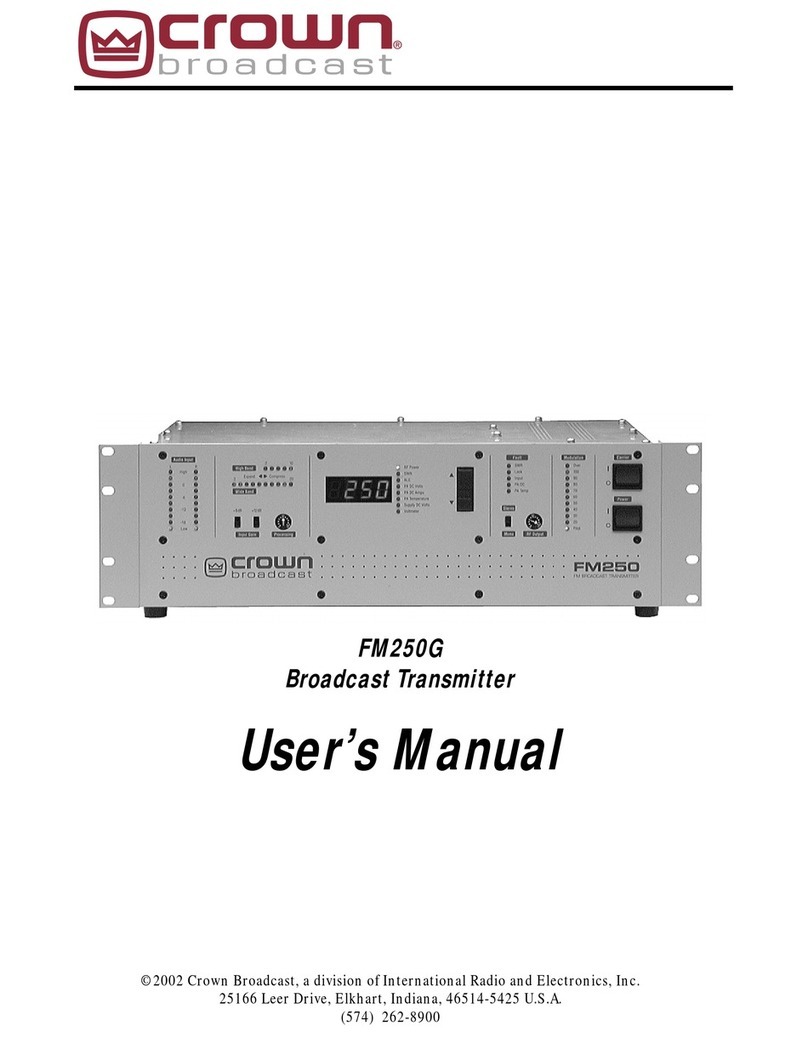
Crown
Crown FM250G user manual
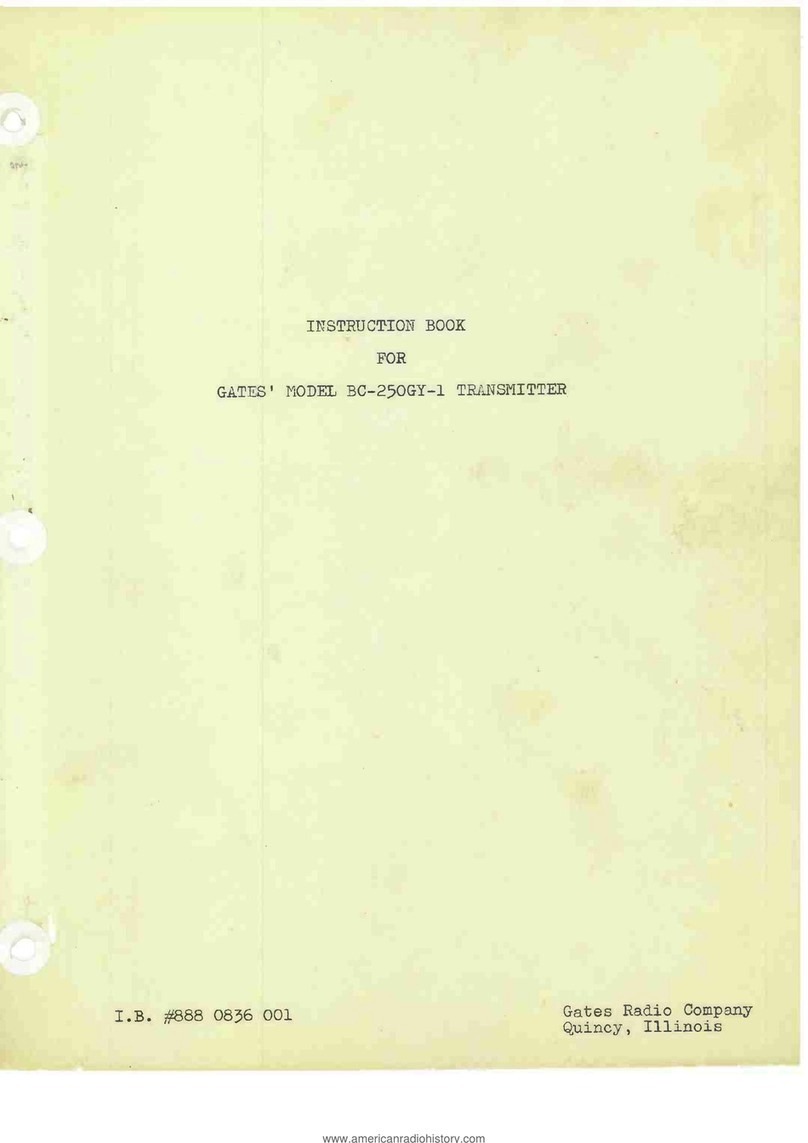
Gates Radio Company
Gates Radio Company BC-250GY-1 Instruction book
